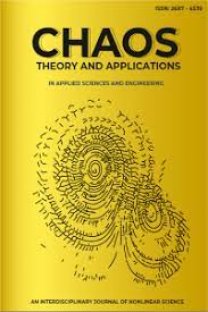Stability Analysis of Bitcoin using Recurrence Quantification Analysis
Stability Analysis of Bitcoin using Recurrence Quantification Analysis
___
- Alqaralleh, H., A. A. Abuhommous, A. Alsaraireh, et al., 2020 Modelling and forecasting the volatility of cryptocurrencies: A comparison of nonlinear garch-type models. International Journal of Financial Research 11: 346–356.
- Aste, T., 2019 Cryptocurrency market structure: connecting emo- tions and economics. Digital Finance 1: 5–21.
- Bastos, J. A. and J. Caiado, 2011 Recurrence quantification analysis of global stock markets. Physica A: Statistical Mechanics and its Applications 390: 1315–1325.
- Bielinskyi, A. and O. Serdyuk, 2021 Econophysics of cryptocur- rency crashes: an overview .
- Chaim, P. and M. P. Laurini, 2019 Nonlinear dependence in cryp- tocurrency markets. The North American Journal of Economics and Finance 48: 32–47.
- Eckmann, J.-P., S. O. Kamphorst, and D. Ruelle, 1987 Recurrence plots of dynamical systems. Europhysics Letters (EPL) 4: 973– 977.
- Härdle, W. K., C. R. Harvey, and R. C. G. Reule, 2020 Under- standing cryptocurrencies. Journal of Financial Econometrics 18: 181–208.
- Huffaker, R., R. G. Huffaker, M. Bittelli, and R. Rosa, 2017 Nonlinear time series analysis with R. Oxford University Press.
- Kucherova, H. Y., V. O. Los, D. V. Ocheretin, O. V. Bilska, and E. V. Makazan, 2021 Innovative behavior of bitcoin market agents during covid-19: recurrence analysis. In M3E2-MLPEED, pp. 1–15.
- Marwan, N., N. Wessel, U. Meyerfeldt, A. Schirdewan, and J. Kurths, 2002 Recurrence-plot-based measures of complexity and their application to heart-rate-variability data. Phys. Rev. E 66: 026702.
- Marwan, N., N. Wessel, U. Meyerfeldt, A. Schirdewan, and J. Kurths, 2013 A comprehensive bibliography about rps, rqa an their applications.
- Mezquita, Y., A. B. Gil-González, J. Prieto, and J. M. Corchado, 2022 Cryptocurrencies and price prediction: A survey. In Blockchain and Applications, edited by J. Prieto, A. Partida, P. Leitão, and A. Pinto, pp. 339–346, Cham, Springer International Publishing.
- Moloney, K. and S. Raghavendra, 2012 Examining the dynamical transition in the dow jones industrial. Physics Letters A 223: 255–260.
- Packard, N. H., J. P. Crutchfield, J. D. Farmer, and R. S. Shaw, 1980 Geometry from a time series. Phys. Rev. Lett. 45: 712–716.
- Piskun, O. and S. Piskun, 2011 Recurrence quantification analysis of financial market crashes and crises .
- Sasikumar, A. and B. Kamaiah, 2014 A complex dynamical analysis of the indian stock market. Economics Research International 2014.
- Soloviev, V. and A. Belinskiy, 2018 Methods of nonlinear dynam- ics and the construction of cryptocurrency crisis phenomena precursors .
- Soloviev, V., O. Serdiuk, S. Semerikov, and A. Kiv, 2020 Recur- rence plot-based analysis of financial-economic crashes. CEUR Workshop Proceedings.
- Soloviev, V. N. and A. Belinskiy, 2019 Complex systems theory and crashes of cryptocurrency market. In Information and Communica- tion Technologies in Education, Research, and Industrial Applications, edited by V. Ermolayev, M. C. Suárez-Figueroa, V. Yakovyna, H. C. Mayr, M. Nikitchenko, and A. Spivakovsky, pp. 276–297, Cham, Springer International Publishing.
- Strozzi, F., E. Gutiérrez, C. Noè, T. Rossi, M. Serati, et al., 2008 Measuring volatility in the nordic spot electricity market us- ing recurrence quantification analysis. The European Physical Journal Special Topics 164: 105–115.
- Strozzi, F., J.-M. Zaldívar, and J. P. Zbilut, 2007 Recurrence quan- tification analysis and state space divergence reconstruction for financial time series analysis. Physica A: Statistical Mechanics and its Applications 376: 487–499.
- Takens, F., 1981 Detecting strange attractors in turbulence. In Dy- namical Systems and Turbulence, Warwick 1980, edited by D. Rand and L.-S. Young, pp. 366–381, Berlin, Heidelberg, Springer Berlin Heidelberg.
- Tredinnick, L., 2019 Cryptocurrencies and the blockchain. Business Information Review 36: 39–44.
- Webber Jr, C. L. and J. P. Zbilut, 1994 Dynamical assessment of physiological systems and states using recurrence plot strategies. Journal of Applied Physiology 76: 965–973, PMID: 8175612.
- Xing, Y. and J. Wang, 2020 Linkages between global crude oil market volatility and financial market by complexity synchro- nization. Empirical Economics 59: 2405–2421.
- Yuan, Y. and F.-Y. Wang, 2018 Blockchain and cryptocurrencies: Model, techniques, and applications. IEEE Transactions on Sys- tems, Man, and Cybernetics: Systems 48: 1421–1428.
- Zbilut, J. P., 2005 Use of recurrence quantification analysis in eco- nomic time series. In Economics: Complex Windows, pp. 91–104, Springer.
- Zbilut, J. P. and C. L. Webber, 1992 Embeddings and delays as derived from quantification of recurrence plots. Physics Letters A 171: 199–203.
- Yayın Aralığı: 3
- Başlangıç: 2019
- Yayıncı: AKİF AKGÜL
On the Prediction of Chaotic Time Series using Neural Networks
Josue Alexis MARTİNEZ-GARCİA, Astrid Maritza GONZALEZ-ZAPATA, Ericka Janet RECHY-RAMİREZ, Esteban TLELO-CUAUTLE
The Evolution of Fractional Calculus
The FPGA-Based Realization of the Electromagnetic Effect Defined FitzHugh-Nagumo Neuron Model
Stability Analysis of Bitcoin using Recurrence Quantification Analysis
Xiaoting YANG, Liguo YUAN, Zhouchao WEİ
Muhammed Ali PALA, Murat Erhan ÇİMEN, Mustafa Zahid YILDIZ, Gökçen ÇETİNEL, Emir AVCIOĞLU, Yusuf ALACA
Experimental Validation of a Chaotic Jerk Circuit Based True Random Number Generator
R. Chase HARRİSON, Benjamin K. RHEA, Ariel OLDAG, Robert N. DEAN, Edmon PERKİNS
